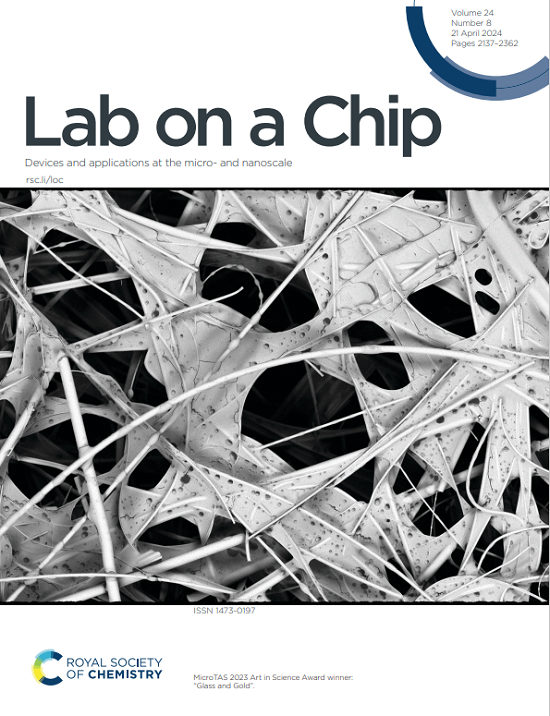使用可定制的3D打印井套构建多个微环境龛
IF 5.4
2区 工程技术
Q1 BIOCHEMICAL RESEARCH METHODS
引用次数: 0
摘要
对先进的体外模型的需求日益增加,这些模型可以复制器官内部和器官之间细胞类型之间的生理串扰,需要在单个平台内安排定制的细胞微环境。水凝胶是一种生物材料,它模拟了组织壁龛的物理化学特性,以最佳地支持多种细胞类型。然而,它们需要与细胞模式平台(如生物打印或微流体)集成,以创建有组织的多生态位环境。生物打印具有可扩展性,但受可打印水凝胶可用性的限制,而微流控图案与多种生物材料兼容,但具有挑战性,目前在生物打印和微流体图案之间存在差距。在这里,我们开发了本地化微环境Well-Insert (LM-Well),这是一种3d打印设备,设计用于在多孔板中定制具有物理化学特性的多个水凝胶壁龛。LM-Well的图图化结构可以实现各种水凝胶配方的毛细管力驱动图图化,包括天然的、光交联的和合成的点击水凝胶。功能材料,例如清除氧气的微胶囊,可以在LM-Well中形成模式,为单个细胞壁龛中的局部氧气水平提供额外的控制层,从而调节肿瘤球形生长和肝脏活动的分区。微结构支撑,如微柱或支架,可以集成到LM-Well中,以最佳方式支持机械活性细胞,如肌细胞。LM-Well的多生态位模式功能使其能够在单孔中建立肝脏-肿瘤共培养,重现了heparg来源的肝细胞激活他莫昔芬和灭活阿霉素后MCF-7肿瘤细胞的药物疗效变化。作为一个多功能和可访问的平台,LM-Well通过可定制的生态位和多种生物材料促进生理相关的共培养。本文章由计算机程序翻译,如有差异,请以英文原文为准。
Building multiple microenvironmental niches using a customizable 3D printed well insert
The increasing demand for advanced in vitro models that replicate physiological crosstalk between cell types within and between organs requires customized cellular microenvironments arranged within a single platform. Hydrogels are biomaterials that mimic the physicochemical properties of tissue niches to optimally support diverse cell types. However, they require integration with cell patterning platforms like bioprinting or microfluidics to create organized multi-niche environments. There is currently a gap between bioprinting, which is scalable but limited by availability of printable hydrogels, and microfluidic patterning, which is compatible with diverse biomaterials but is challenging to multiplex. Here, we developed the Localized Microenvironment Well-Insert (LM-Well), a 3D-printed device designed to pattern multiple hydrogel niches with customizable physicochemical properties in multi-well plates. The LM-Well features patterning structures that enable capillary force-driven patterning of various hydrogel formulations, including natural, photo-crosslinkable and synthetic click hydrogels. Functional materials, exemplified by oxygen-scavenging microcapsules, can be patterned within the LM-Well offering an additional layer of control over local oxygen levels in individual cell niches, which modulated tumor spheroid growth and zonation of hepatic activities. Micro-architectural supports, such as micropillars or scaffolds, can be integrated into the LM-Well to optimally support mechanically-active cells like myocytes. The LM-Well's multi-niche patterning capability enabled the establishment of a liver-tumor co-culture in a single well, recapitulating altered drug efficacy on MCF-7 tumor cells following activation of tamoxifen and deactivation of doxorubicin by HepaRG-derived hepatocytes. As a versatile and accessible platform, the LM-Well facilitates physiologically relevant co-cultures with customizable niches and diverse biomaterials.
求助全文
通过发布文献求助,成功后即可免费获取论文全文。
去求助
来源期刊

Lab on a Chip
工程技术-化学综合
CiteScore
11.10
自引率
8.20%
发文量
434
审稿时长
2.6 months
期刊介绍:
Lab on a Chip is the premiere journal that publishes cutting-edge research in the field of miniaturization. By their very nature, microfluidic/nanofluidic/miniaturized systems are at the intersection of disciplines, spanning fundamental research to high-end application, which is reflected by the broad readership of the journal. Lab on a Chip publishes two types of papers on original research: full-length research papers and communications. Papers should demonstrate innovations, which can come from technical advancements or applications addressing pressing needs in globally important areas. The journal also publishes Comments, Reviews, and Perspectives.
 求助内容:
求助内容: 应助结果提醒方式:
应助结果提醒方式:


